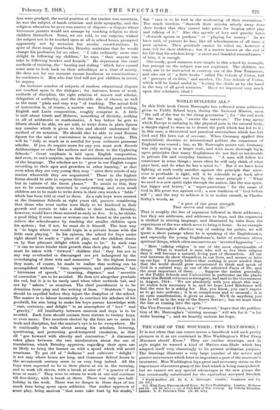THE CARE OF THE WOUNDED : TWO TEXT-BOOKS. t IT
is not often that one comes across a handbook with such pretty pictures in it as are contained in Miss Waddington's lVhat Every Masseuse should Know.' They are outline drawings, and in style might be termed a kind of Matisse-cum-Slade which has adapted itself very charmingly to its present utilitarian purpose. The drawings illustrate a very large number of the active and passive movements which form so important a part of the masseuse's treatment. Miss Waddington lays great and necessary stress on the importance of a correct grasp of the limb which is being manipulated but we cannot see any special advantages in the new grasps she has occasionally substituted for the equivalent accepted Swedish
• World-Builders AU. By B. A. Burroughs. London : Longmans and Co. [2s. net.]
t(1) What Every Masseuse should Know. By Vera Waddington. London : Methuen and Co. [2s. 6d. net.j—(2) A Teat-Boot of War Nursing. By Violetta Thurston. London: G. 1'. Putnam's Sons. [3s. Od. uct.j
remedial methods. The book is an elementary one, and should prove of great value to students in training, especially to those taking the necessarily rather pernmicaned six months' course.
Miss Thurstan' alludes incidentally to the need for more massage in military hospitals in her notes on Roehampton. She comments on the fact that a number of amputation cases have to be sent back to Brighton for treatment—this because during their stay in hospital enough attention has not been paid to massage and movements, and the stumps are consequently too wasted, or the joint remains too stiff for the fitting of an artificial limb, Much valuable time and many hundreds of valuable beds are being wasted by the shortage of massage and electro-therapy in our first-line hospitals in England. Miss Thurstan's book deals chiefly with the special problems of nursing in France and " at the front " generally. It should prove a most valuable book to the probationer going abroad for the first time. It is clearly arranged and contains a large amount of thoroughly practical information. We do not think that trained Sisters, however, for whom Miss Thurstan appar- ently also intends her book, will find much in it that is new to them. It is essentially a beginner's book, and was surely originally intended as such. It was perhaps by some oversight that a section in which the hospital worker is advised to possess scissors and a watch with a second-hand, or informed that the dressing usually applied to a wound after operation consists of sterilized squares of gauze and is completed by oottonwool and a bandage, was ad- dressed to Sisters and not to probationers. But we are grateful to Miss Thurstan for that rare thing, a really practical handbook on a branch of nursing.



































 Previous page
Previous page